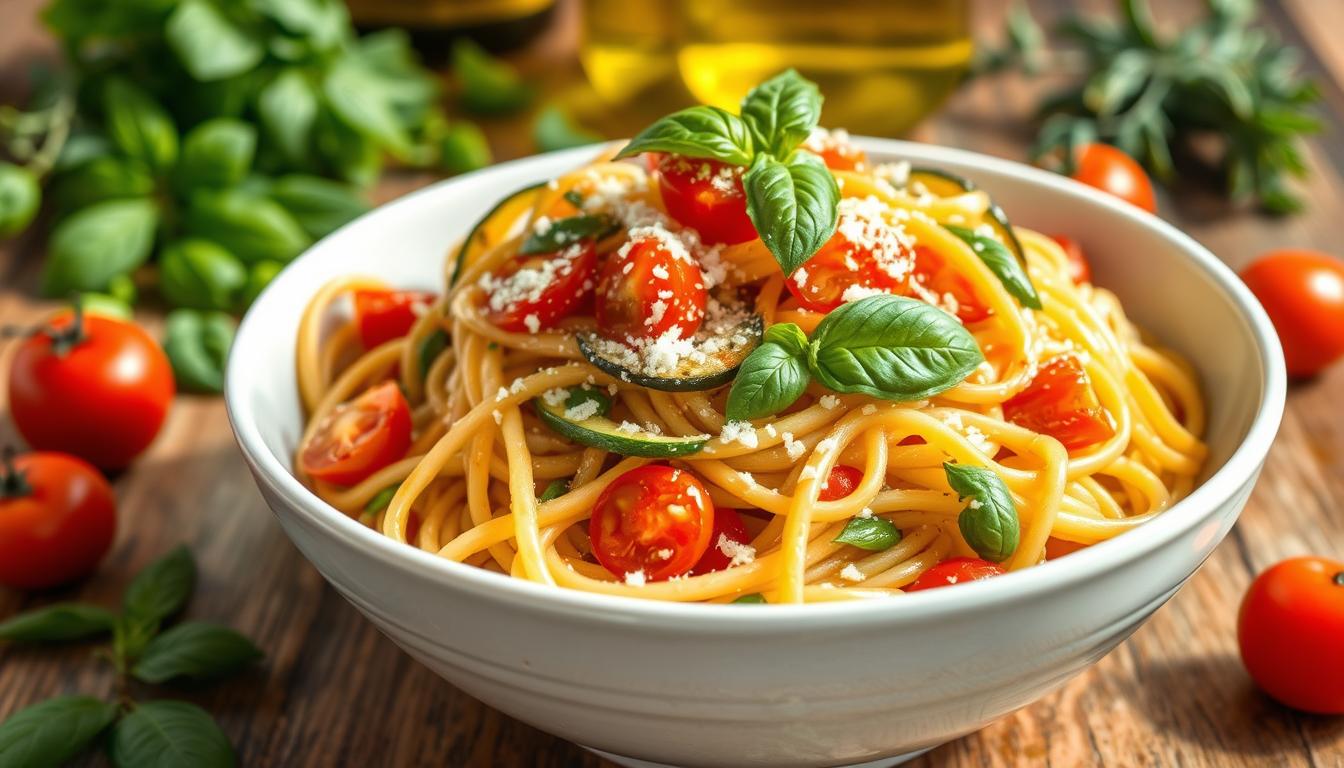Pasta Primavera is a vibrant and flavorful Italian dish that celebrates the fresh, seasonal produce of spring and summer. This vegetable-packed pasta is a delightful option for both vegetarians and meat-lovers alike, offering a light and healthy alternative to heavier pasta dishes. With its origins in the classic Italian cuisine, Pasta Primavera has become a beloved staple in modern Italian-American restaurants, known for its ease of preparation and its ability to showcase the vibrant flavors of the season’s best produce.
In this recipe, we’ll guide you through the process of creating a restaurant-quality Pasta Primavera in your own kitchen, using a delightful combination of fresh vegetables, herbs, and a flavorful sauce to create a dish that is both visually stunning and incredibly delicious. Whether you’re looking for a simple, meatless weeknight meal or an elegant dinner party centerpiece, this Pasta Primavera recipe is sure to impress and delight your taste buds.
Essential Ingredients for Perfect Pasta Primavera
Pasta Primavera is a vibrant and flavorful dish that celebrates the bounty of seasonal vegetables. To create an exceptional Pasta Primavera, it’s essential to start with high-quality, fresh ingredients. From crisp seasonal vegetables to aromatic herbs, each component plays a vital role in bringing this classic Italian dish to life.
Fresh Vegetables and Herbs
The heart of Pasta Primavera lies in the selection of seasonal vegetables. Some classic options include:
- Asparagus
- Peas
- Zucchini
- Carrots
- Bell peppers
- Cherry tomatoes
Don’t be afraid to experiment with other seasonal favorites, such as broccoli, cauliflower, or snow peas. Ensure all the vegetables are freshly sourced and vibrant in color. Complement the vegetables with a variety of fresh herbs, such as basil, parsley, and chives, to add depth and fragrance to the dish.
Pasta and Sauce Components
The pasta of choice for Pasta Primavera is typically a long, thin shape, such as spaghetti, linguine, or fettuccine. This allows the vegetables and sauce to cling to the noodles, creating a harmonious blend of flavors and textures. For the sauce, a light, creamy base made with olive oil, garlic, and white wine or lemon juice is the perfect canvas to showcase the fresh vegetables.
Seasonings and Garnishes
To elevate the flavors of Pasta Primavera, don’t forget to season the dish with salt, pepper, and a touch of grated Parmesan cheese. A drizzle of high-quality olive oil or a sprinkle of toasted pine nuts can also add a delightful finishing touch to the dish.
| Ingredient | Quantity | Purpose |
|---|---|---|
| Asparagus | 1 lb | Provides fresh, crunchy texture |
| Peas | 1 cup | Adds sweetness and bright color |
| Zucchini | 2 medium | Contributes moisture and subtle flavor |
| Linguine | 8 oz | Ideal pasta shape for Pasta Primavera |
| Olive oil | 1/4 cup | Basis for the light, creamy sauce |
| Garlic | 3 cloves | Enhances the overall flavor profile |
| Parmesan cheese | 1/2 cup, grated | Provides a savory, nutty finish |
Pasta Primavera Recipe: Step-by-Step Instructions
Crafting the perfect Pasta Primavera dish is a delightful culinary journey. Let’s dive into the step-by-step instructions to create this vibrant and flavorful pasta masterpiece. From mastering the cooking techniques to achieving the al dente texture, this guide will ensure you savor every bite of your homemade Pasta Primavera.
- Start by prepping your fresh vegetables. Finely chop the asparagus, zucchini, bell peppers, and onions, ensuring even-sized pieces for even cooking.
- Bring a large pot of salted water to a boil and cook the pasta of your choice, such as spaghetti or fettuccine, until it reaches the perfect al dente texture, following the package instructions.
- In a large skillet, heat a generous amount of olive oil over medium-high heat. Add the chopped onions and sauté them until they become translucent and fragrant.
- Introduce the remaining chopped vegetables to the skillet and sauté them for about 5-7 minutes, or until they are tender but still have a slight crunch. This technique of sautéing the vegetables preserves their vibrant colors and fresh flavors.
- Once the pasta is cooked, drain it and add it directly to the skillet with the sautéed vegetables. Toss the pasta and vegetables together, ensuring even coating.
- Create the Pasta Primavera sauce by whisking together heavy cream, Parmesan cheese, lemon juice, and a pinch of salt and pepper. Pour the sauce into the skillet and gently toss everything together until the pasta is evenly coated.
- Finish the dish by garnishing it with freshly chopped basil, parsley, or other fragrant herbs. Serve the Pasta Primavera hot and enjoy the burst of spring flavors in every bite!
| Cooking Technique | Benefit |
|---|---|
| Sautéing vegetables | Preserves the vibrant colors and fresh flavors of the vegetables |
| Achieving al dente pasta | Provides the perfect texture and bite to the dish |
| Creating a creamy Pasta Primavera sauce | Enhances the overall flavor and cohesion of the dish |
By following these step-by-step instructions, you’ll be able to create a Pasta Primavera dish that’s worthy of a fine dining restaurant. Enjoy the vibrant blend of fresh vegetables, al dente pasta, and the creamy Pasta Primavera sauce for a delightful spring-inspired meal.
Tips for Making Restaurant-Quality Pasta Primavera
Elevating your homemade Pasta Primavera to restaurant-quality standards is easier than you might think. Start by carefully selecting the freshest, seasonal vegetables and herbs to ensure optimal flavor and texture. When it comes to the pasta, opt for a high-quality brand or, better yet, make your own fresh pasta for an authentic touch.
To enhance the overall flavor profile, don’t be afraid to experiment with different seasonings and garnishes. A drizzle of fragrant olive oil, a sprinkle of grated Parmesan, or a handful of fresh basil leaves can make all the difference. Additionally, consider adding a splash of white wine or lemon juice to the sauce for a bright, zesty finish.
When it comes to cooking techniques, pay close attention to the timing and doneness of your vegetables. Lightly sautéing or blanching the vegetables can help them retain their vibrant colors and crisp-tender texture, rather than overcooking them. Lastly, pay attention to the presentation of your dish – a beautifully plated Pasta Primavera can elevate the overall dining experience and make your homemade meal feel truly restaurant-worthy.

